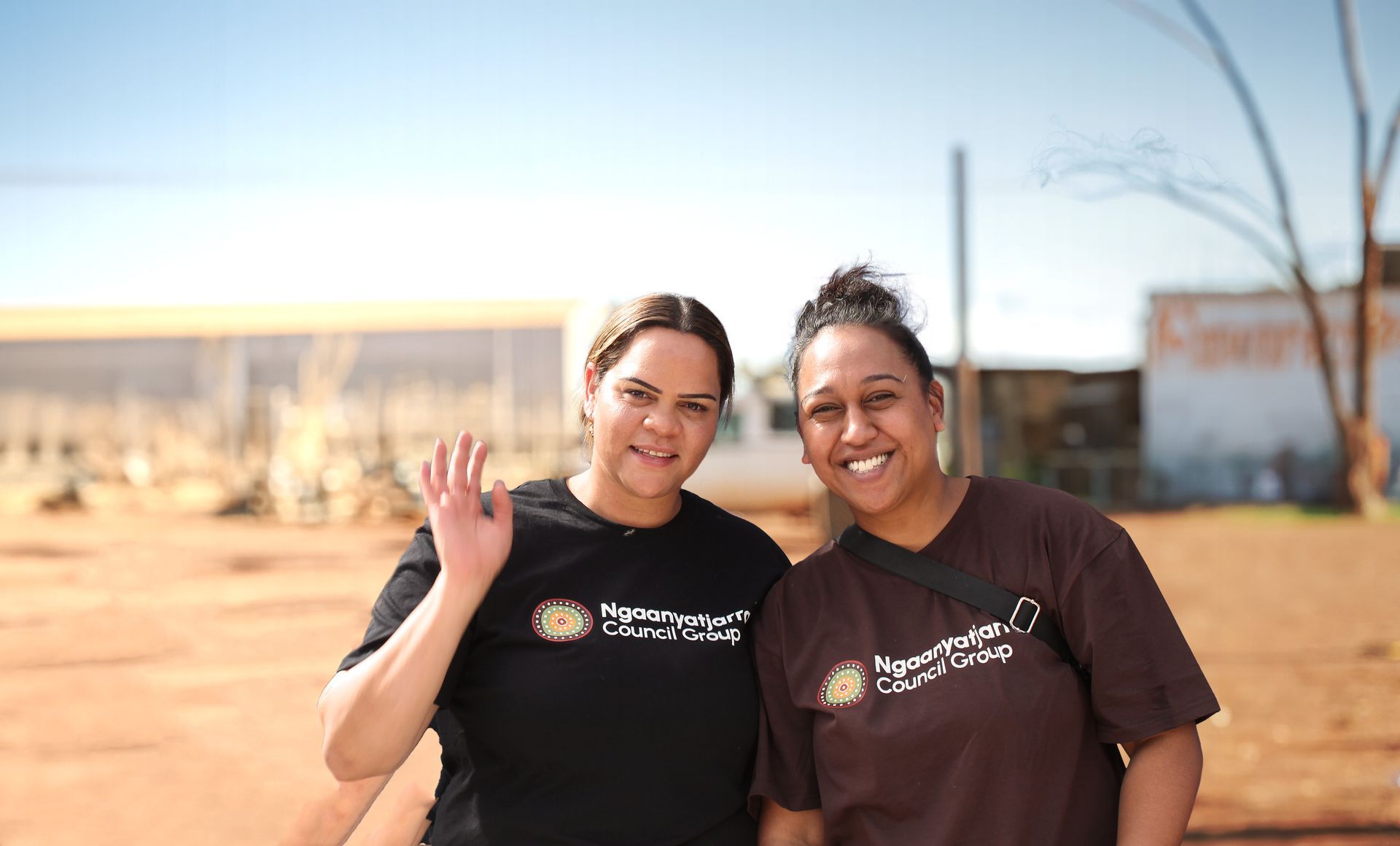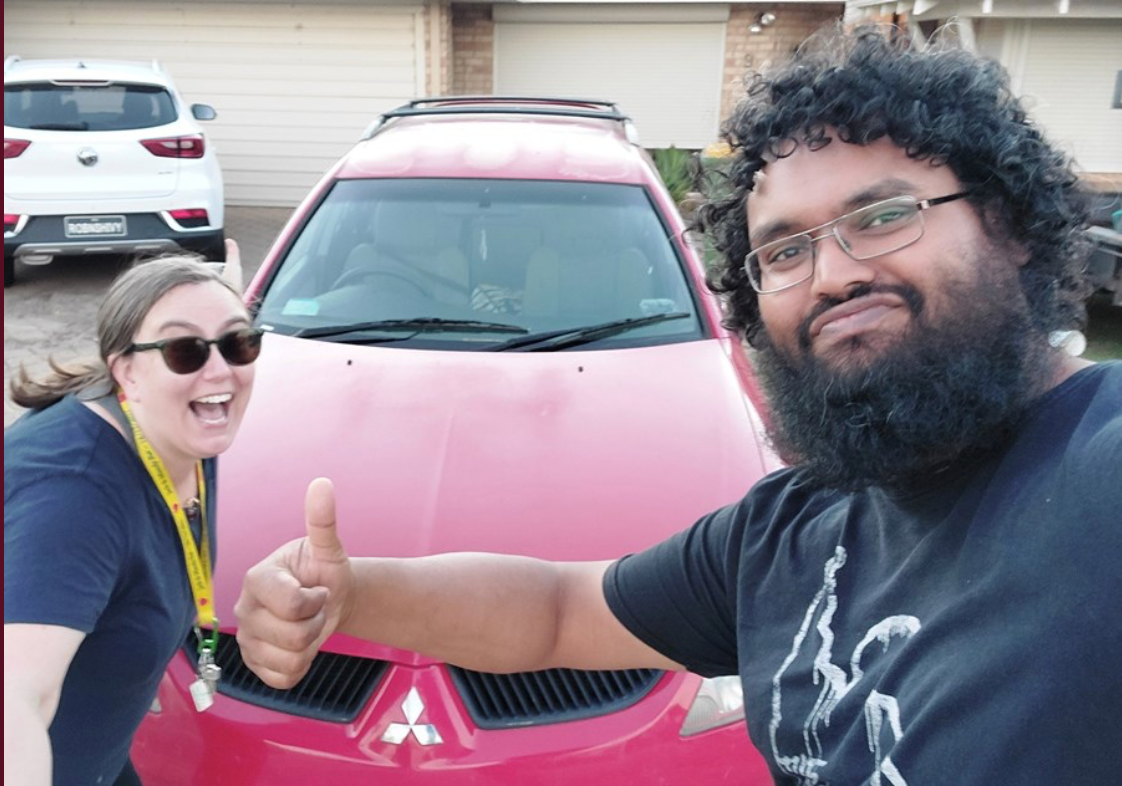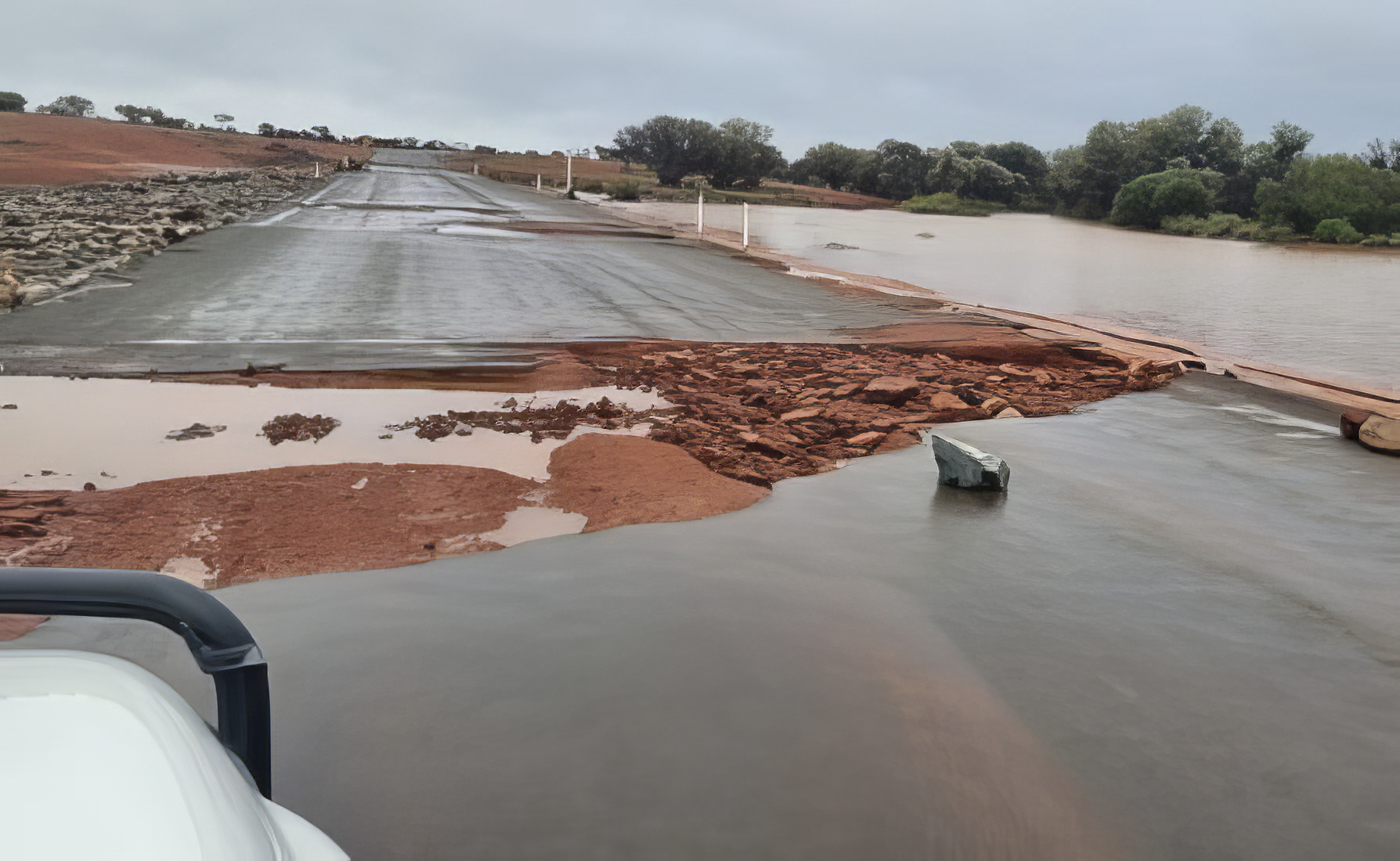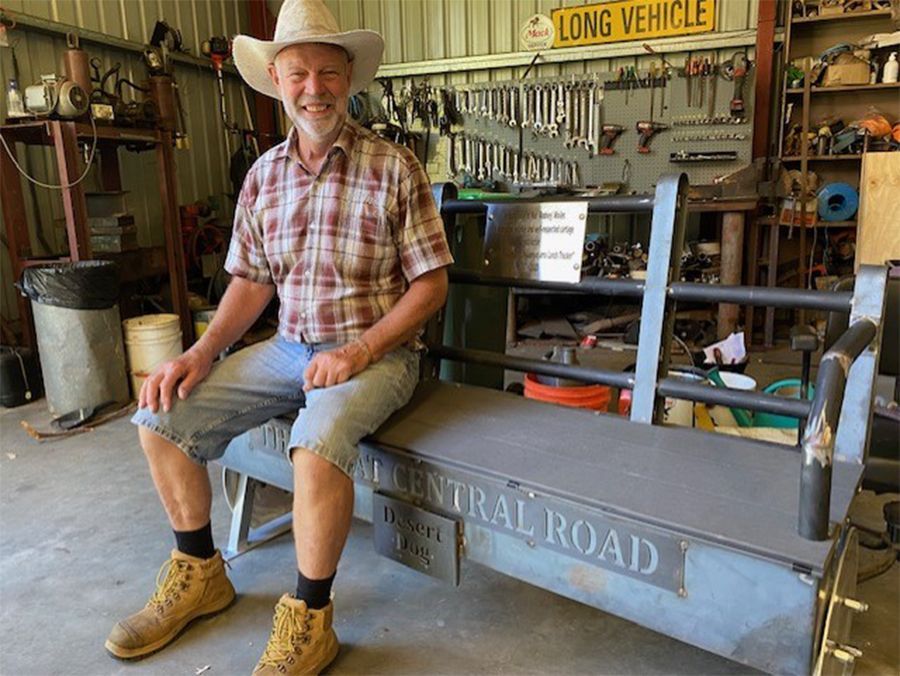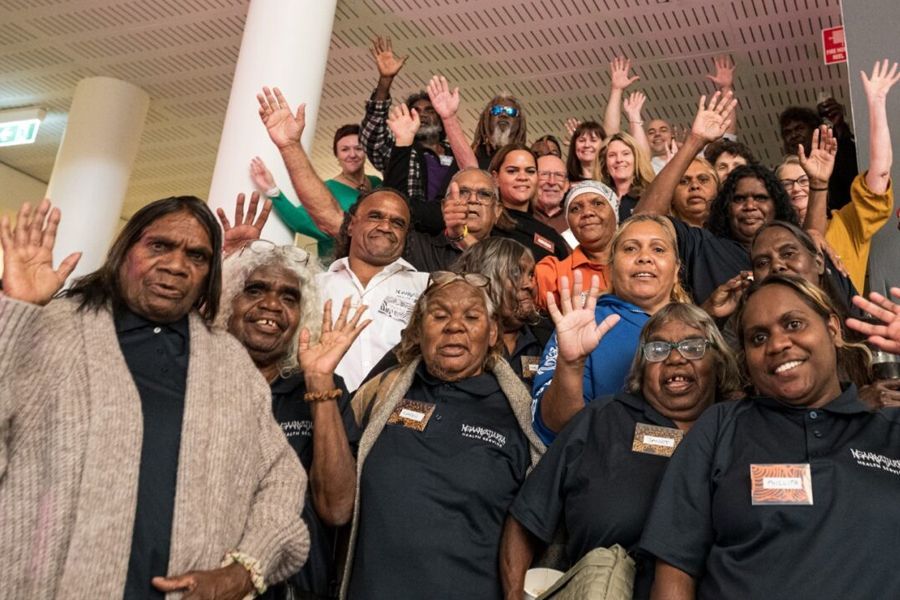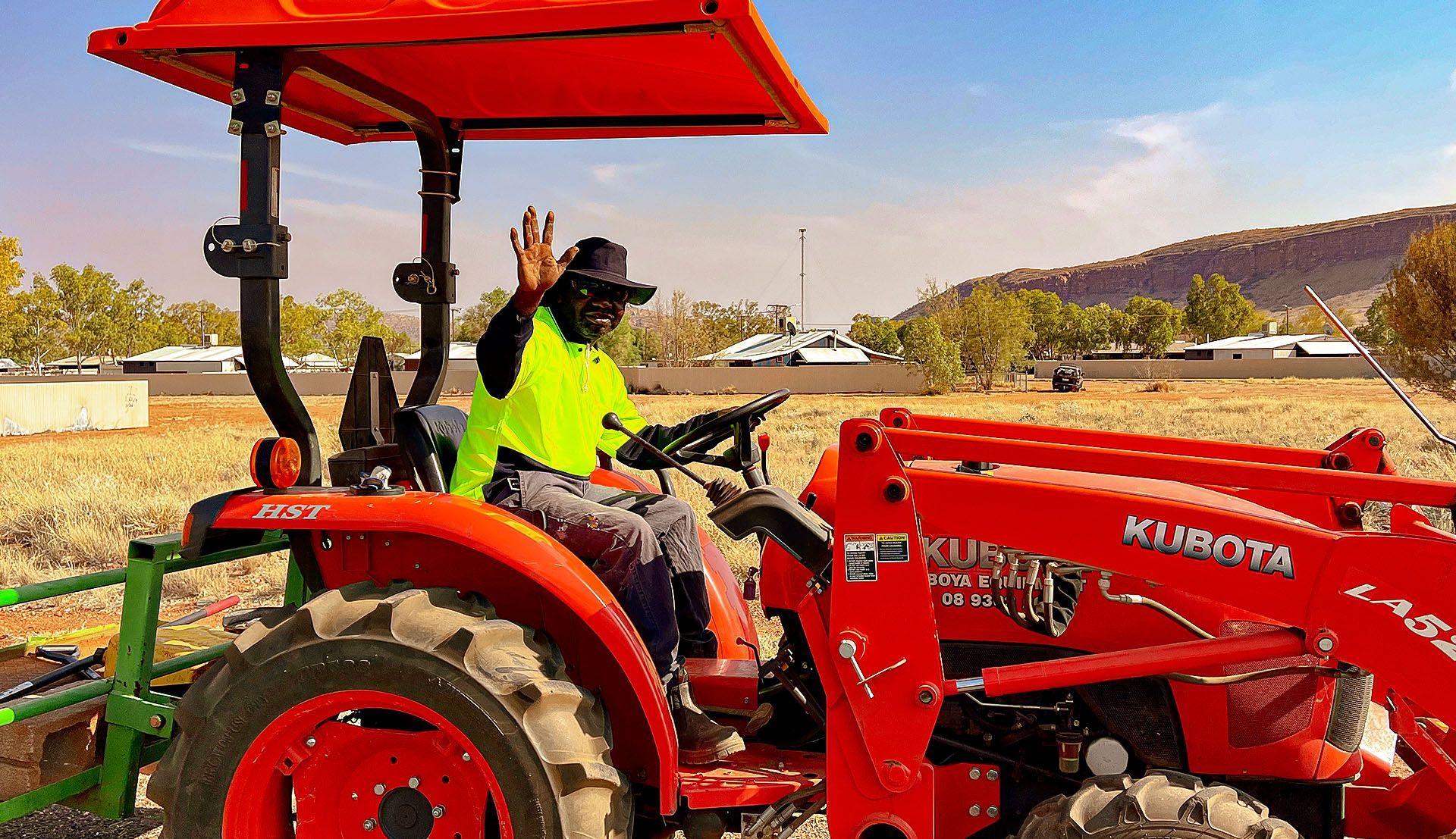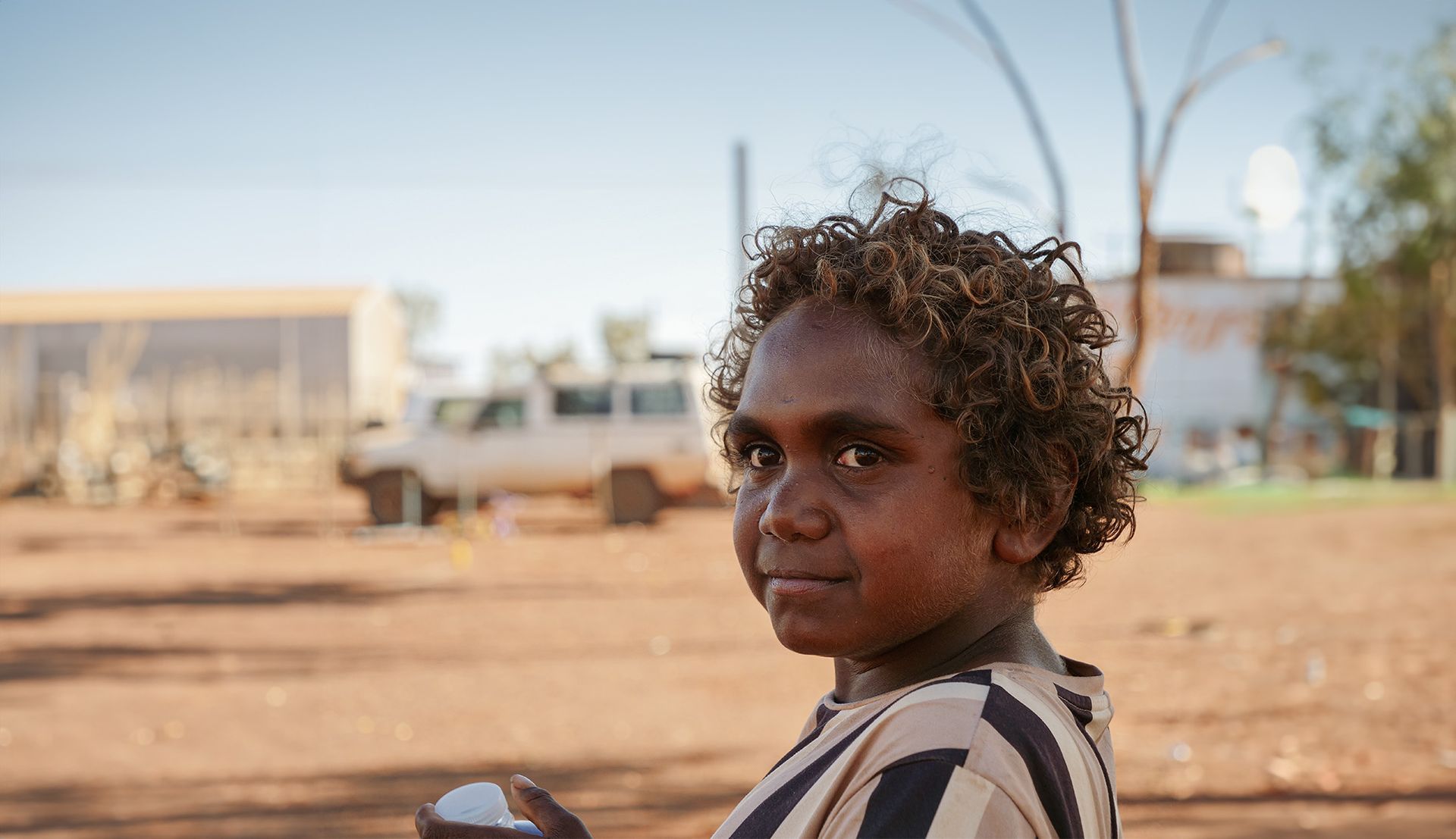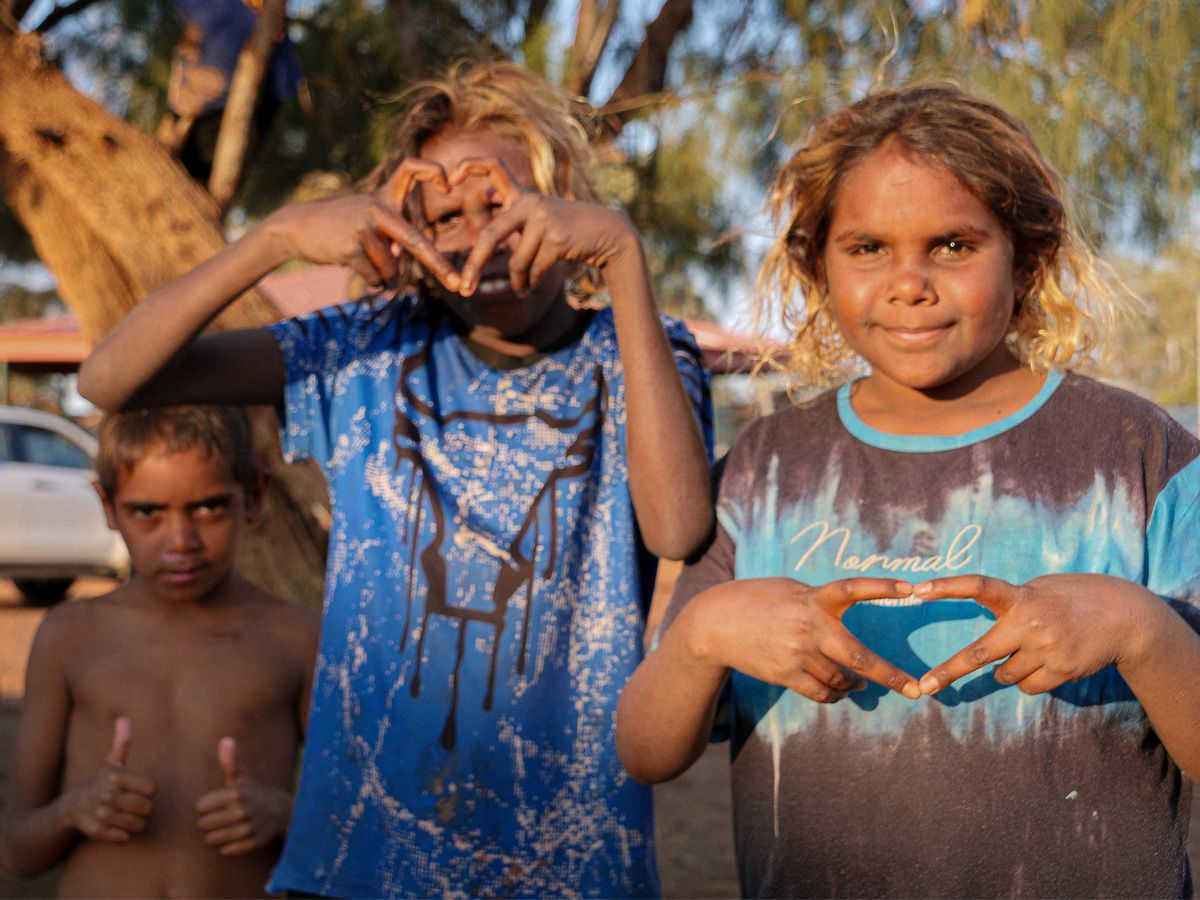News
News
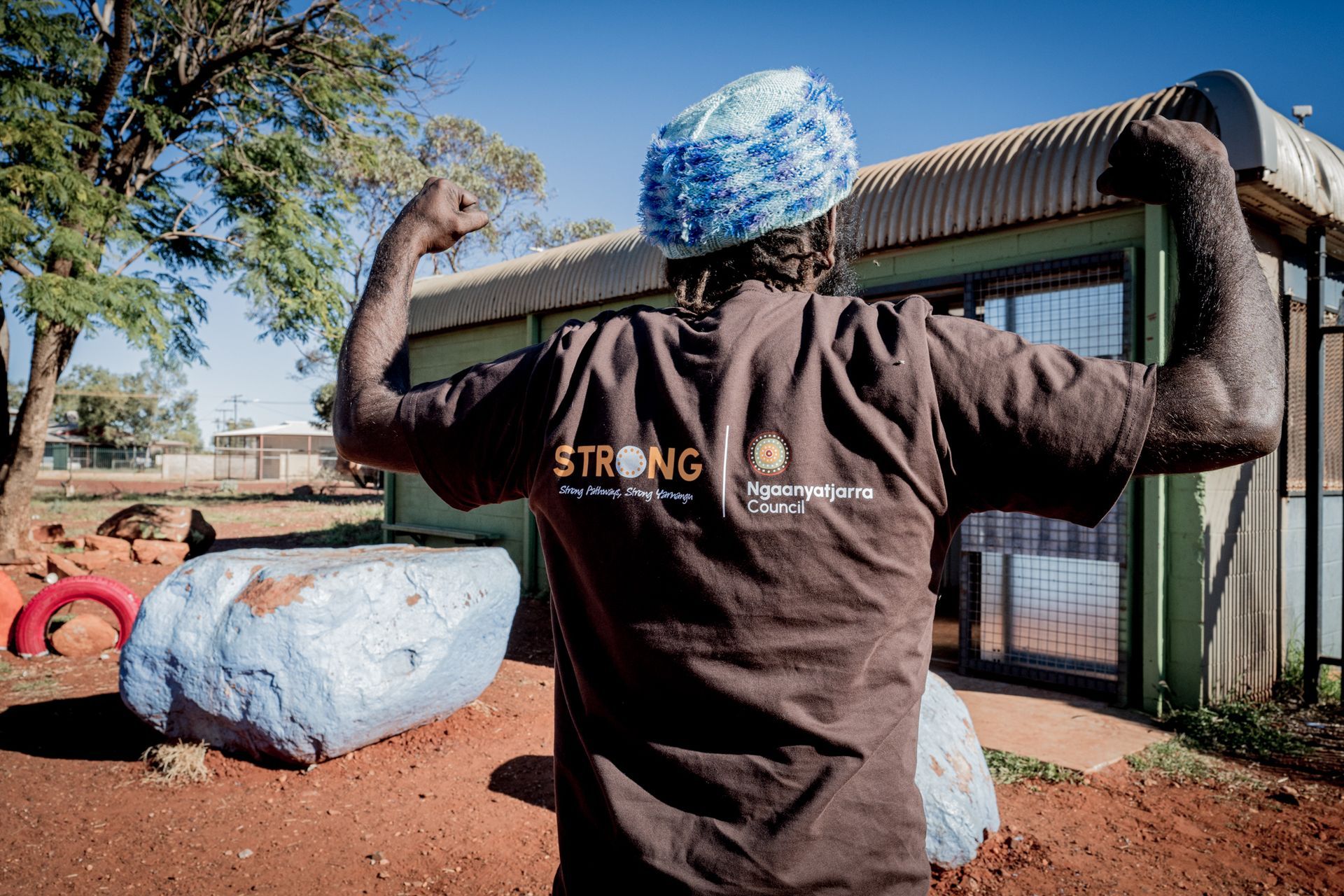
By Natasha Perkins
•
04 Jul, 2024
On July 3, a significant milestone was reached with the launch of the ‘STRONG’ Community Development Program (CDP) in Warburton. This initiative, a partnership with the National Indigenous Australians Agency (NIAA), marks a monumental step forward for the �������Ƶ lands, its people, and their future. The STRONG program aims to provide genuine work opportunities for Yarnangu, with over 40 new jobs in the initial trial phase. At today's launch, ten employment contracts were signed, both in Warburton and via online streamed communities across the Lands. The goal is clear: Strong Pathways and Strong Yarnangu. By creating strong pathways to work, we can ensure that Yarnangu remain strong on the Lands. This collaborative effort between our CDP team and the government has resulted in a program that not only meets these needs but also empowers the community through sustainable and meaningful work. Sonja Voogd Armstrong, General Manager of CDP, expressed the excitement shared by many at the program’s launch. “This is the culmination of months of work by our CDP people on the Lands and our Perth CDP team, along with many others,” Sonja said. “Ralph Addis, Thomas Williams, our CEO, Mr. Fred Chaney, and the NIAA staff have all invested significant time and effort to turn this possibility into a reality.” “While this is a trial, there is potential for expanding the program to create genuine, enduring work opportunities for Yarnangu,” she continued. “Substantive work and strong pathways for the future are essential for fulfilling the aspirations of Yarnangu to remain on the land and flourish. Today marks the beginning of something with a long, strong future.” The STRONG program starts with 45 jobs for Yarnangu, but it signifies a deeper cultural shift—not only for them but also in how CDP and the Council support work on the Lands.
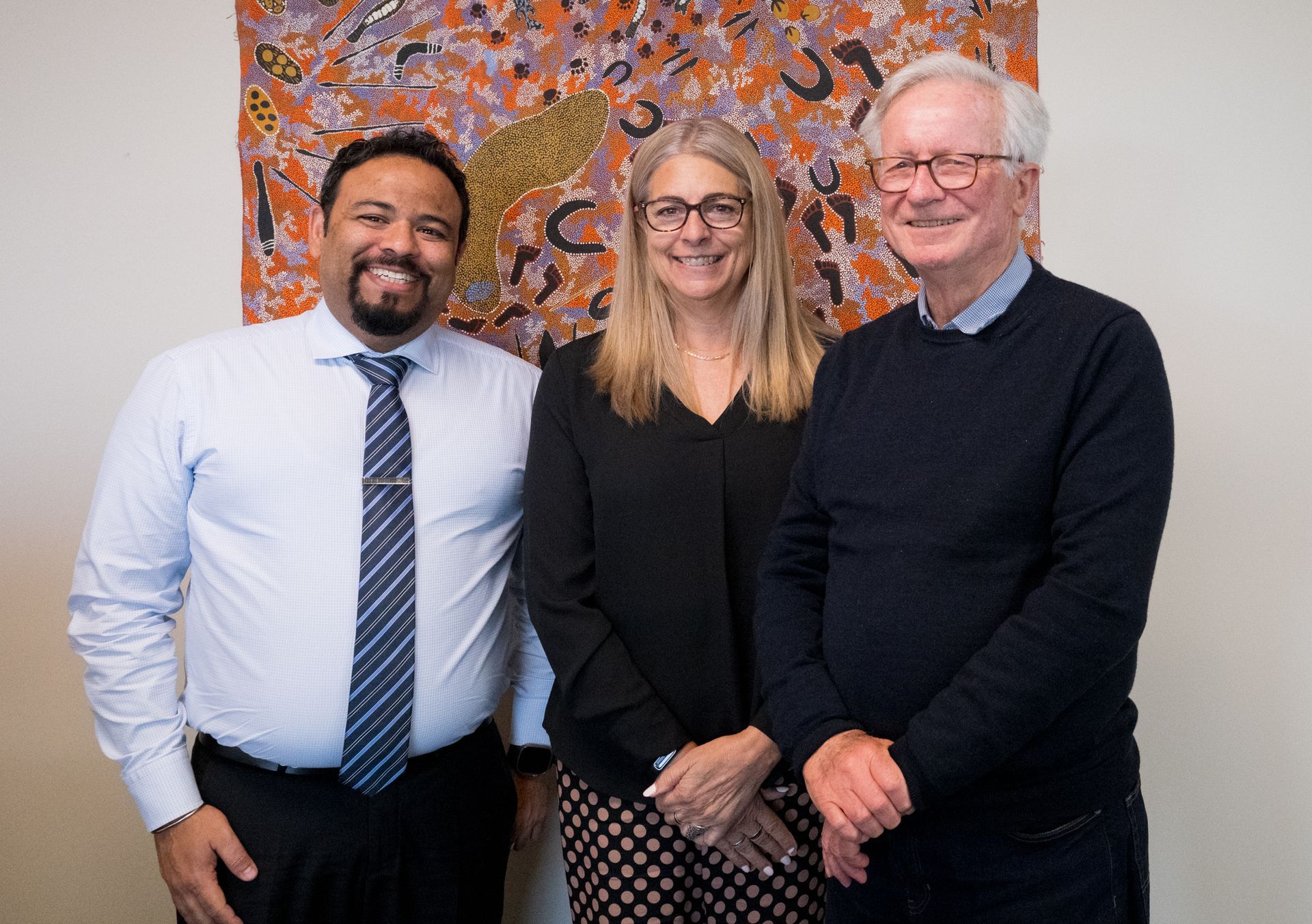
By Natasha Perkins
•
01 Jul, 2024
�������Ƶ Council Group has appointed Jodie Matthews as General Manager of Youth and Education for the eleven member communities on the Lands. The new role has been created to collaborate with the Education Department of Western Australia and other service providers to improve educational outcomes for youth on the Lands. The role is highly integrated with other functions within the Council, recognising the significant impact of multiple factors on education outcomes. "This new role has been created to oversee the delivery of culturally responsive initiatives that target education and training programs from early childhood (before school), children and youth, and adult education," Jodie said. Jodie is a former Principal of the school at Warburton (2013-2014) and later returned in 2017 as Executive Deputy Principal based at Warakurna. Having previously worked with the Education Department at the regional office in Kalgoorlie, Jodie's role included frequent visits to support the �������Ƶ schools and their principals. Her familiarity with the network of schools on the Lands, their potential, and challenges runs deep. In announcing the new role, CEO of �������Ƶ Council Group, Thomas Williams, highlighted the importance of the appointment. "We’re taking this significant step to ensure our members have the strongest foundation possible for flourishing on the Lands," Thomas said. "It’s another step to helping Yarnangu lead lives filled with purpose and agency and remain on the Lands." While introducing Jodie to the Council’s employees, Fred Chaney - a friend of the �������Ƶ and Board Advisor - also emphasised the role's significance. "This is a terrific day for the people on the Lands and for the Council. Education has always been a critical key for people having a strong future," Fred said. "The challenge of equipping Yarnangu to walk in two cultures is a large one—we are well aware of the realities of this challenge." "Like so many areas—housing, health, employment, and families among them—education is interrelated. The approach by the Council’s CEO is holistic and it needs to be as we’re addressing systemic issues on the Lands. Jodie’s appointment is another piece in the jigsaw that combines to create a picture of flourishing through all of our member communities," Fred added. Jodie’s role, effective immediately, will lead the Council’s advocacy for child and youth education. While based at the Council’s head office, Jodie will spend significant time within the communities on �������Ƶ Lands.
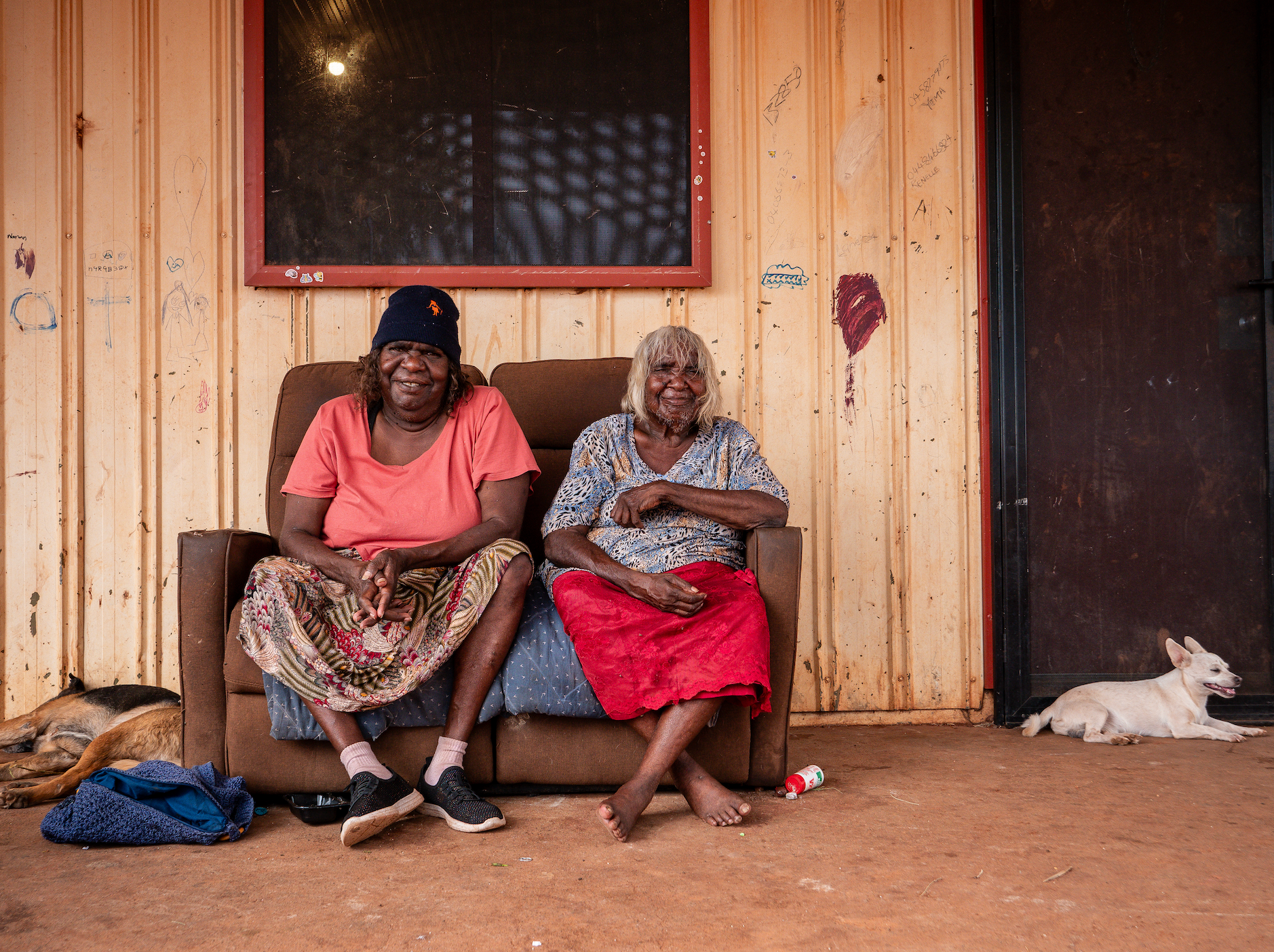
By Natasha Perkins
•
26 Jun, 2024
Starting July 1, the �������Ƶ Lands will standardise to a single time zone, marking a significant alignment for our communities. For years, the challenge of operating across different time zones has posed issues for the eleven member communities, with six following Western Standard Time (WST) and five adhering to Central Standard Time (CST). This division has often led to confusion, inefficiencies, and operational difficulties for our staff and the communities we serve. Recognising these challenges, our Community Development Advisors (CDAs), in collaboration with feedback from the Western Australia Police Force (WAPOL) and the Education Department, have proposed unifying the entire �������Ƶ Lands under Western Standard Time (WST). Consultations with key personnel across the Lands have revealed strong support for the move to one time zone, emphasising its potential to streamline daily operations, enhance service coordination, and boost community engagement. Aligning with our strategic objectives, this move aims to improve operational efficiency and increase community satisfaction. By adopting a single time zone, we anticipate smoother communication, better scheduling, and a unified sense of time that will benefit everyone involved. We look forward to seeing the positive impacts this change will bring to our communities.
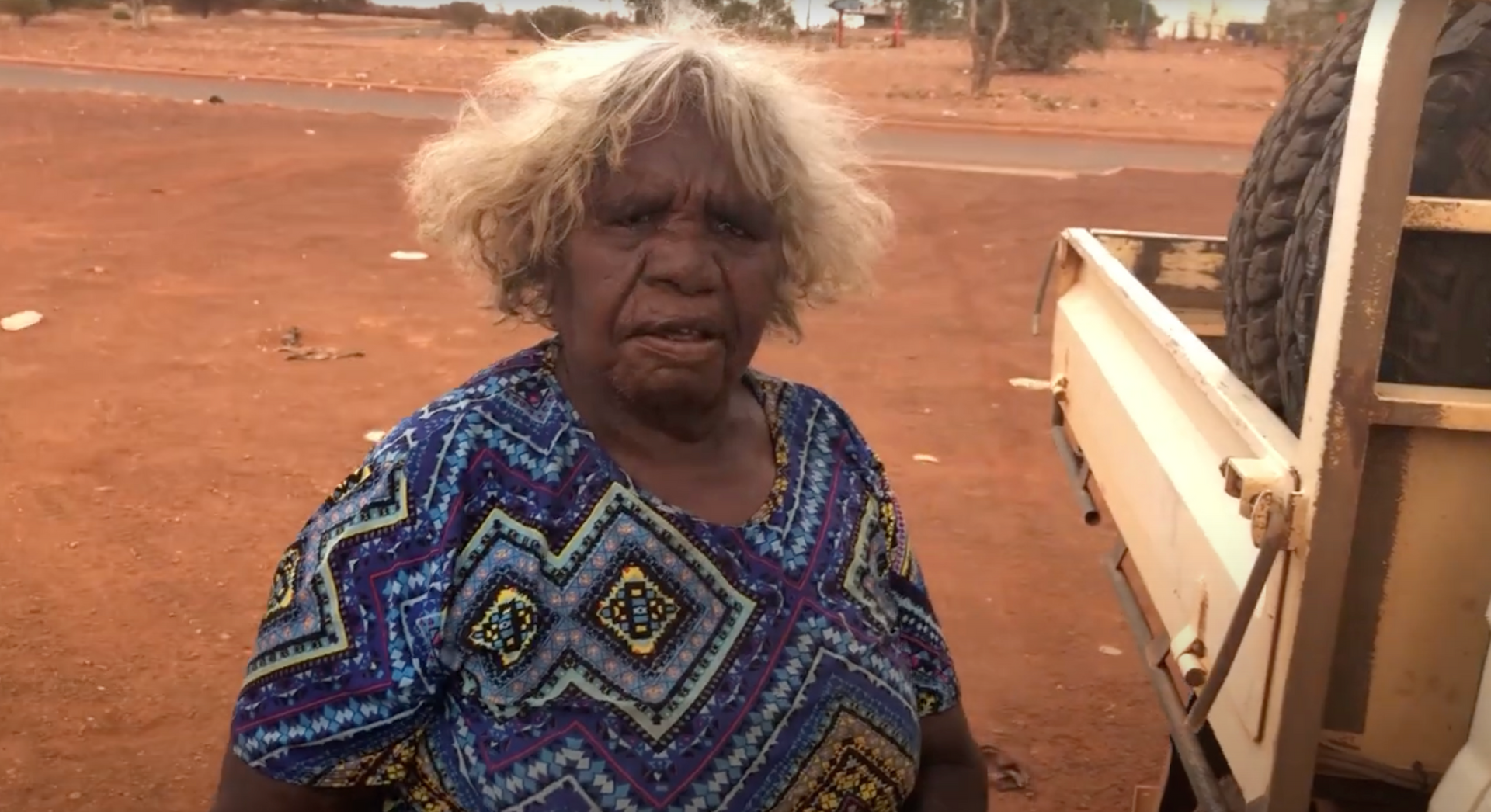
By Natasha Perkins
•
31 May, 2024
Thomas Williams had only recently been appointed CEO of �������Ƶ Council after 17 years with the organisation when one of our community members stopped him in his tracks. Nancy Tjungupi Carnegie is an artist and preserver of bush medicine. Nancy was born near Patjarr at a place called Pandaltjarra where she lived a traditional life into early adulthood. She is a prolific painter and avid hunter, often leaving Patjarr on foot to pursue tinka (goanna) in the remote Pila Nature Reserve. Nancy is currently the chairperson for Patjarr community and represents Patjarr’s interests as a director with Warakurna Artists. As Thomas visited communities in the �������Ƶ group, he met with Nancy. “Nancy predominantly speaks in the �������Ƶ dialect with an occasional English word, so I generally communicate with her through a translator. On this occasion, Angelica McLean was with me and helping us to have a conversation together,” Thomas recalls. “Nancy was kindly congratulating me on my appointment, but it was one word that was familiar to me that stopped me in my tracks and caused me to ask Angelica to get Nancy to repeat what she had just said,” “I heard the words SILOS,” “My first thought was, ‘How does she even know this word as a woman living on these lands for many years’” “Angelica repeated what Nancy had said: ‘Now you have the opportunity to remove the silos - do it’,” Thomas said. It wasn’t an ultimatum, but it was undoubtedly a strong invitation. Even Nancy, removed from the politics and machinations of an Aboriginal Corporation, could spot something evident to her: silos within an organisation are a recipe for dysfunction. Silos are contained areas of function that stand alone and apart from other functions within an organisation or system. Integration is necessary for there to be a free flow of information, collaboration and the ability to identify opportunities and efficiencies. Silos are often the product of institutional insecurity as people within a system seek to ‘protect their turf’, but they’re also one of the most significant obstacles to progress in an organisation. “So obvious were some of these silos that Nancy could spot them from thousands of kilometres away. I found that sobering,” Thomas said. “As I have navigated the early stages of my role as CEO of �������Ƶ Council, Nancy’s words have been among those that have fuelled my work,” “We’ve already accomplished plenty, yet there’s so much work ahead of us because when some of that work is addressing the silos that thwart progress, that’s not always simple or comfortable,” “But our mission is to see Yarnangu leading lives filled with purpose and agency, thriving in a culture-rich environment—for their aspirations to stay on country be realised,” “Every time we make a decision that moves us closer to this, whether it’s in the area of CDP, employment, housing, community development, company culture and values, or bringing our brand into alignment across the Council, we move one step closer to ‘removing the silos’ and realising the aspirations of Yarnangu on the lands,” Thomas said. Silos can thwart progress, no doubt, but confronting them in any institutional setting is complex, sometimes slow, work. “Sometimes people like Nancy can spot the silos from thousands of kilometres away that we can miss from the trenches. Her plea has been life-giving for what we’re trying to accomplish day-by-day at �������Ƶ Council,” Thomas said. Thanks, Nancy.
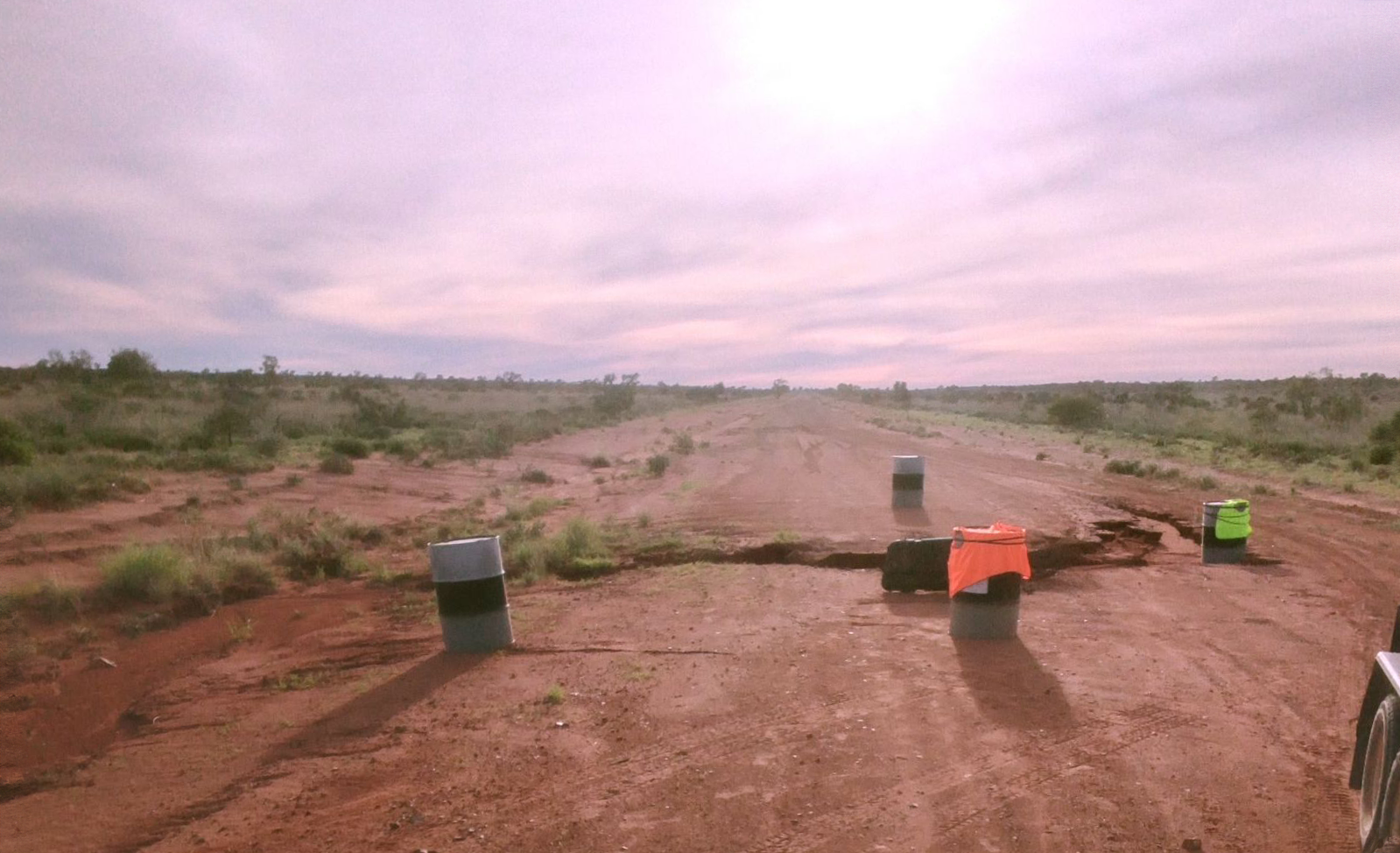
By Natasha Perkins
•
30 May, 2024
It may seem a moon ago now, but as roads were flooded and access to many communities severed, stories emerged of how a team from Kiwirrkurra seized the moment to shine. It had been seven weeks since heavy haulage had reached Kiwirrkurra, and the community was almost out of water, food, and other key supplies. After seeing the state of the roads near their community and being aware that the roads team from the Shire of Laverton could not help, it was time to act. David Brown, �������Ƶ CDP Engagement Officer, has been part of a team that has delivered water to the community for years and believed his team could get the job done. Before commencing the work, David informed DFES of their plans to fix the road as long as The Shire of East Pilbara was prepared to accept (and fund!) the proposal. Ten minutes later, they had a green light! Steve from the Shire was more than happy to engage the Kiwirrkurra community and �������Ƶ staff in road repairs so that trucks could travel to Kiwirrkurra with urgent food and water for the community. The first job was to inspect washouts from the flood and place caution drums around the most dangerous washouts. David contacted another worker, Mr Simon Brown, and advised him of the situation and whether he could assist. “Simon was at my door in no time, keen to get going,” recalls David Brown. He also brought along Kiwirrkurra jobseeker Joseph West, who was keen to assist. “After inspecting the stretch of road and placing drums to warn traffic, a plan of action was put into place to prepare the grader on Sunday and repair the road on Monday, allowing the road to be open again ahead of a food delivery on Wednesday,” David said. Early Monday morning, Simon was at my door, keen to move. “We headed off towards the WA/ NT border. After 70 kilometres, we came across our first washout at Mt Winparku; we removed the caution drums, placing one at each end of the work site to warn incoming traffic that the grader was engaged in repairing the road,” David said. After a long day, the task was completed, and all three washout locations were repaired. “It was so satisfying for us to be able to say that the road would be open for Wednesday’s much-needed store truck delivery,” “Our store managers, Sammi and Steve, along with the rest of the community, were so happy to see the truck roll in on Wednesday morning after six weeks of road closures from the heavy rains,” remembers David. While this may seem like a story about the resourcefulness of the group of workers who identified an opportunity, proposed a plan, and fixed a problem, it’s also testimony to the resilience of every member of the Kiwirrkurra community who kept on working away despite the isolation and uncertainty caused by the road closures. After the successful remediation and reopening of this stretch of road, David is now training his team for possible future collaborations with the Shire on this stretch of road from Kiwirrkurra to the NT border. What a sensational outcome for the Kiwirrkurra community and �������Ƶ staff who worked together to obtain a significant result for the community.

By Natasha Perkins
•
21 May, 2024
For many years, reinforced by remoteness, �������Ƶ Lands have been referred to by some as the ‘Hermit Kingdom’. The group of 11 communities who came together by choice in 1981 to form the �������Ƶ Council, were staunchly independent and rarely reached beyond themselves. Given the difficulty of accessing the lands and the reality that only the most ardent travellers traverse the Gunbarrel Highway en route to cities in the north or south, the label was reasonable. Increasingly, though, the ‘Hermit Kingdom’ tag is being shaken off as communities seek to engage culturally, economically and socially with individuals and organisations beyond them. Recognising the necessity for trusted travelling partners committed to journeying with Yarnangu of the �������Ƶ Lands has been pivotal in this emergence. “We identified that to step into our future, we also needed to step out of the shadows,” said �������Ƶ Council CEO, Thomas Williams. “To live lives of purpose and agency with strong families and strong stories, we also need strong partners.” “We need to collaborate and co-create with others to realise the potential for our lands and our people—it’s a land rich with culture and stories, as well as economic potential. But to imagine this better future for all, we need to invite those who’ve taken journeys like ours before and learn with them,” Thomas said. This emergence has gathered pace in recent years. The establishment of BHP’s West Musgrave mine site in the Mantamaru | Jameson community has demanded astute leadership and stewardship of the potential royalties that will flow. “We have seen the damage of the ‘resource curse’ in other Aboriginal communities, and we want to learn from that,” Thomas said. “Being intentional in how we use these royalties for social investment, strong health outcomes, and the future of our people is very important to us.” “We’ve collectively decided to apportion 30% of royalties for the future of our members: 10% into our savings fund, 10% into a renal fund, and 10% into the operation of our land culture division,” Thomas added. It’s another level of stewardship that’s made necessary by possibility. �������Ƶ leaders are being invited to the tables of federal ministers because there’s been a growing awareness of the consistent, long-term management of community assets, businesses and programs. While it hasn’t been a specific goal for the future of Yarnangu, there’s little doubt that the tag of ‘hermit kingdom’ is increasingly being overwhelmed by positive stories of agency, opportunity and possibility on �������Ƶ lands.

By Natasha Perkins
•
17 May, 2024
Just one month ago, Jocelyn Bennett (Project Coordinator) and her partner, Foysal Ahmed (Data Analyst), both of whom work with �������Ƶ Health Service, climbed into a Mitsubishi that they'd purchased for $1,500 and headed for Adelaide to be part of the Autumn Edition of the Shitbox Rally (SBR)—Australia's largest cancer research fundraiser. Jocelyn had one of the most memorable experiences of her life, but she also came away with a host of insights with broader leadership implications. Here are 11 Leadership Lessons based on Jocelyn’s SBR experience! 1. Team Matters When you throw together 6-7 teams of two into a buddy group—some with deep driving and mechanical experience, some with none— none of whom know each other, the wheels can quickly fall off if there isn't a commitment to the team above the individual. "The campsite in the evening was a major undertaking. People arrive at different times depending on their adventures throughout the day. We were a sea of around 300 tents and almost 600 people," "In the evening, there was catered food and organised games, but usually we preferred to hang out and chat with our buddy group, there was always something worth talking about from the day." "We'd sit around, share stories, laughed at the days hardships, and made those friendships that come from adversity. That’s what made the whole thing special." "Out on the road, we'd often see cars from other buddy groups broken down. Sometimes you’d see that their group was spread out over long distances. We never split up though and always made sure we stayed together. You never knew what kind of help would be needed; it wasn’t just mechanical know-how that was required," "It wasn't as though our team was in perfect harmony; long days and stressful events put pressure on everyone, but we worked hard to keep together, even when things were tough," "It's easy enough to get angry or annoyed when someone's problem affects the rest of the group, but we understood that what happens to one happens to all - that's how we worked together," Jocelyn said. The value of 'team' was the glue that made challenging moments bearable, allowed for a sense of levity when required, and brought the best out in people. 2. Adversity creates connection The SBR may be a fundraising powerhouse, but it's also a social experiment. Teams/vehicles are put together into buddy groups with 6-7 other teams. These buddy groups are a mix of experience and inexperience, mechanical and non-mechanical. You have a potentially volatile social dynamic when you combine $1,500 vehicles, vast amounts of daily driving in remote territories, and many people you've just met. "Every buddy group has some mechanics to help with the likely event of mechanical failure or mishap, but they're not the only people of value in a team," "People with clinical skills are important - our buddy group had a registered nurse and a paramedic," "One of our group was quite seriously injured in Ceduna, slicing their fingers on a fan as they were repairing their car. We were fortunate to have them on our team, but also be in a town with a health service that was able to treat the injury, without their help his rally might have ended there," "Early on I noticed that these mishaps - including when our oil sump was damaged - and adversities were when connections were forged," "We were the first car in the group to break down. We’d been making great time and felt awful that we were the ones to cause the hold up on a particularly gruelling day of driving. However, that was the catalyst for bringing us together over the coming seven days." "Without challenges, it takes much longer to forge strong, trusting relationships. You really find out the quality of people when they’re put under trying circumstances. We were all new to one another, so these daily incidents became our shared experiences," Jocelyn explained. One writer, speaking about group dynamics, differentiates community from 'communitas'. Communitas is the sense of sharing and intimacy that develops among people who experience adversity as a group. Many crave belonging without the adversity that brings connection. 'Communitas’ recognises that mission, purpose, and adversity are HOW we get there. 3. 'Mine' = push-ups One of the memorable things about the rally was the blanket ban on the word 'mine'. If anyone was heard to say it, there was the immediate penalty of ten push-ups. This ban reflected a deeply embedded value of collaboration and community, and it applied to everyone, always. "There were some extreme applications of this. After the long briefing in Adelaide, we had one of the teams next to us at the lights. The lights turned green, but the car didn't move. Then we saw the driver step out and bust out ten push-ups on the median strip," "Even the CEO dropped the word in a speech on the first morning and had to offer ten push-ups on top of a car as a penalty," Jocelyn said. The premise is simple: nothing is yours; it's all ours. It's a strong premise for life. It's more about stewardship than possession; if it's yours, it's yours to share. 4. Adversity births Invention The whole point of SBR is the challenge of participating in a car that cost less than $1,500. Not only is this a difficult task in today’s economic climate, it also opens up the participants to mechanical disasters. "There's a temptation to take the easy way out and turn up with a more expensive vehicle - Foys and I were determined not to, there's actually a level of shame in flaunting the rules and going against the spirit of the rally,” "I'm not sure people understand how hard it is to find a car for under $1,500 that is registered and running, let alone one that will drive thousands of kilometres," “One of our teams had a 1977 Alfa Romeo which was overheating. You can’t exactly pick up parts for that in the middle of nowhere, so the mechanics in our group rerouted the window washers to spray extra water on the radiator to keep it going until they had time for a better solution,” Jocelyn remembered fondly. "Not everything could be dealt with on the road, so there was the triage area at the camp each night for cars needing more serious repairs, that was a hive of activity and creativity," "Triage was able to fix almost anything regardless of whether or not they had the perfect spares. They repurposed and reconfigured what they had to get cars ready to pull out of camp the next morning," Jocelyn recalled. Inventions and solutions are driven by need. Necessity is the mother of invention, and, stranded on the side of the road, so is adversity. 5. Knowledge = Power While SBR is not competitive, Jocelyn & Foys’ buddy group found themselves towards the back of the pack due to breakdowns resulting in even longer days. "This actually affected our team. The more time you lose, the later you arrive at camp, the less time you have for eating, hanging out, repairs, and most importantly, sleep" Jocelyn said. “The rally rotates the order in which cars leave camp each day so that you’re not always leaving last, but one bad breakdown can add hours to your already extensive travel time,” "The initial breakdowns galvanised our desire to get into camp early so we could spend time together face to face, not just over the radio. We decided to spend a little extra time each night and in the morning after briefing to plan the upcoming day’s driving,” "Because we started planning together and using each other's strengths, like our local knowledge for instance, we were able to gain ground each day, overtaking other groups who hadn’t planned out their stops," "We had contacts in these remote lands and started to lean on them! We called ahead to people we knew, and they allowed us to take parts we needed from abandoned vehicles so that we could keep moving,” "Foys and I, along with two others in our group, knew of places to stop that weren’t in the route guides, or were less popular, so we avoided long queues and suddenly we weren't finishing at the back of the pack but sometimes in the first handful of buddy groups," Jocelyn said. The leadership lesson? Broad knowledge and experience give you an upper hand against your competition but only when combined with good planning, collaboration, and adapting to local conditions! 6. …but it's not all about what you know The power of knowledge is of little use if it's not combined with collaboration and good relationships. The benefit of knowing the right people, having the correct information, and capitalising on that knowledge is multiplied when it's shared with your team, and when you work with the people supporting you. "Some teams floundered because they failed to stick together. When things got tough, they seemed to fracture rather than be forged into something stronger," Jocelyn said. "It's like working for the �������Ƶ Group; if we stick together, with our focus on the vision and mission of what we're about, we're going to realise some powerful outcomes," "But if we fracture whenever something gets tricky, or fail to value everyone’s knowledge and experience, we also get stuck or move backwards," "We may not get there perfectly, but we're moving forward with a team that's growing together, celebrating the small wins, and feeling supported together as we go," Jocelyn said. Institutional knowledge is powerful, but it can be leveraged by collaboration with the team around you to build upon the legacy that's been established. 7. Collaboration makes everyone better When people bring their best to the table with an eye on possibility, great things can happen. "One of the things that I loved about SBR was that it was like a distilled version of working on the Lands," Jocelyn said. "You have a goal at the beginning of the day to get from one place to another, and you have to work together as a team to make that happen. It's not without curve balls and unexpected adventure, but the goal remains,” “To begin, you think that the most valuable people in any group are the mechanics, but you realise as the rally unfolds that everyone plays their part,” "You think all of these adventures bring everyone together, but that wasn't true of every group or team. The same sorts of problems that united our group divided others, and at times you could hear the frustrations over the radio chatter,” “What helped our team grow together was leaving our egos at the door, and a determination not let challenges derail our goal,” Jocelyn said. Putting collaboration at the heart of a team doesn’t remove the possibility of bang-ups and hang-ups, but it brings something more powerful to the table to keep the convoy moving! 8. Seemingly small moments can be indelible Leaders can sometimes focus on broad, systemic changes within organisations, and that's important, but often, it's also the small moments that, when dignified and recognised, can bring profound cultural change. "Something I noticed as we moved to the more remote parts of SBR was how impactful the rally stops were for small communities, particularly Oodnadatta and Penong," "Community members were driving hundreds of kilometres to support the rally coming through their community. It wasn't all about the spectacle as much as the impact that it was having on their community," "While it was a rally stop for us, it was a boost to the economy of their communities— perhaps the 500 of us showing up on their doorstep may be as many visitors as they normally see over several months!" "The communities host all the catering and entertainment and receive income through campsite fees, and it helps support their sporting clubs and community groups," "It made us eager for our communities, like Warburton, to ready themselves for when the rally comes through, as was originally intended this year," Jocelyn observed. It's a long bow to draw, but small, consistent, targeted actions of recognition, celebration, and action can have an indelible mark on an organisation's culture and an individual's morale. What might seem like a one-off occurrence for some, will have a lasting effect on others. 9. A big 'why' changes everything Knowing the bigger story behind what you are part of shapes how you respond to the ups and downs of life within an organisation. The occasional rollercoaster can be endured if the 'why' is great, understood, and well communicated. "Rally days are big days—plenty happens, and not all of it enjoyable," "We can be tired and annoyed with people and ourselves sometimes as we were in continued and close contact with one another," "While much of that was fun, it certainly wasn't all sunshine and roses," "What made it bearable was that beyond the immediate, we knew we were part of something bigger. Everyone in the rally has been impacted by cancer in some way, and being part of Australia’s biggest community fundraiser for the Cancer Council keeps you going," "It reminded me of our work with people on the Lands. People are working hard and long, and some of that can involve friction, but we have an enduring why: helping Yarnangu flourish on Country, and that brings perspective to those difficulties," Refocussing and realigning on your 'why' brings fresh eyes to problems and setbacks that we'll never spot if we're stuck in the trenches. 10. The Lands are large One of the enormous attractions of having a team from within �������Ƶ Health Service within SBR is that the rally route traversed the Lands… Until flooding intervened, rendering the original route impassable. "We thought that not driving through the Lands meant we wouldn't see any Yarnangu; that we wouldn’t get that connection. Not true," Jocelyn said. "We saw quite a lot of community members on the road—some because they were enduring the same detour as us, others because they'd been off Country for a long time but were now living elsewhere such as Ceduna or APY Lands," "Mr Kinari (Chairperson of the �������Ƶ Board) spends time on APY lands, as do other community members" "We saw numerous people from the Lands who were quick to stop us for a chat when they saw the signage on our car," "What was so beautiful was that, despite a field of nearly 250 vehicles, they suddenly saw something they recognised, and they were so excited to see something they could connect to," "One of my favourite parts of the whole rally was those little moments when we became a small connection to Country for some people—it reminded me of how large the Yarnangu diaspora is, across Australia and beyond," "It felt like a community outreach of sorts!" Jocelyn commented. While our desire is to see the aspirations of Yarnangu flourish and remain strong on country, it's also a reminder of how members of these relatively small remote communities take their culture with them as they go. 11. From little things, big things grow The Shitbox Rally was founded by James Freeman in 2009 after he lost both of his parents to cancer 12 months apart. It was a good idea that became a grand idea. The commitment from the beginning was that all money raised would be given to Cancer Council. The very first rally, from Sydney to Alice Springs in 2010, featured 23 cars and raised $103,000. It was far beyond the wildest expectations. The Autumn edition of 2024 (there are at least two events a year now) has raised $3,001,001 and brings the cumulative total raised to $46,189,166. "The government funds a lot of Cancer research, but those that don’t get government funding are passed on to the Cancer Council so that any charity fundraising can support this research," "So great is the impact of SBR, that of the 12 cancer research projects in this tier, 11 are funded by SBR - it's remarkable," "It's the largest community fundraiser for the Cancer Council in Australia - bigger than ‘The Biggest Morning Tea' or anything else – it has a huge impact," "As a health service, we're always trying to get people well, and this is the sort of stuff that helps us do that," Jocelyn said. Do not despise the day of small beginnings! ——- Plenty happens on a rally that, all up, took around eight days. Jocelyn came away with a depth of experience and application that made another SBR irresistible. "My recommendation to anyone even slightly curious about being part of Shitbox Rally: 'Just do it, you won’t regret it'" Jocelyn encouraged. https://www.shitboxrally.com.au/

By Natasha Perkins
•
10 May, 2024
Supplying food and fresh produce to the remote communities of �������Ƶ Lands isn’t your typical grocery run, it’s a fortnightly process involving ordering, scheduling and a whole lot of driving! The scope and scale of travelling through the Western Desert would be difficult to conceive for your typical city driver who occasionally takes a trip ‘down south’! NATS’s (�������Ƶ Agency and Transport Services) driver, Rod Moiler, a stalwart and icon of the organisation for over three decades, shared some insight into what it looks like to bring supplies into the eleven communities that form the �������Ƶ Council. “For 33 years, my rhythm was a fortnightly run that began on Wednesday with a pick-up of the big order from FAL (now Metcash) in Canning Vale. From there, it would be back to NATS in Welshpool, and on Thursday, we would get deliveries for each community in order, as well as any other supplies that needed to be distributed,” Rod said. “I’d also make sure that I had the truck fully sorted and good to go with other supplies that may be helpful to others along the way—extra water, fresh fruit from my fruit trees at home, puncture kits to help other travellers out of a tight spot, and newspapers for the graders,” “On Friday, I’d haul out of Perth, usually stopping outside of Kalgoorlie,” “By Saturday, all going well with the weather and breakdowns—never a sure thing—I’d be driving in Warburton. It’s never a sure thing because conditions are variable. The Western Desert experiences soaring temperatures that remind you to ensure your air-con is in good working order, but also experiences flash flooding that can get derail even the most experienced driver. “There was a time when I was stuck in Laverton for a week waiting for the road to be drivable, and another when I did a load out to Alice Springs and back because it was impossible to drive west, but the need was desperate, so I headed east,” Rod said. “There were other times where I got stuck in one of the communities because of the weather. I’d end up helping the store owners with some welding or stacking the shelves to fill in the time before I could get back out on the road,” he adds. Rod took the initiative to bring newspapers for the operators of the road graders as well as fresh fruit. He figured out quickly enough that everyone helps each other in these remote places, and he might need some road grading to make a delivery before too long. More than once, those operators drove through the night to clear a path so Rod could make his next delivery. As Rod would make his way out of Warburton on a Sunday, it would be along a route that became increasingly familiar. “As I went from Jameson to Wanarn and on to each of the communities, I’d be delivering as well as backloading,” “There’d be different supplies that needed to head back to Perth—from the Education Department or Police, or even a stranded tourist or their car—they’d be loaded on board as I made my way around the lands,” “By Tuesday, I’d be back in Warburton, backloading anything from there before heading back to Perth on Wednesday morning,” Rod says. “I’d arrive back in Perth late Thursday afternoon and then unload all the backloaded supplies at NATS,” “Then, I’d spend the weekend with my family before spending Monday and Tuesday servicing the truck and getting it ready to do it all again on Wednesday!” Unsurprisingly, Rod has clocked up plenty of kilometres out on the Lands. Over his career, a conservative estimate of 70,000 kilometres each year adds up to nearly 2.5 million kilometres on the road. He speaks fondly of his trucks, favouring Macs above all others across the years. “Five of my seven trucks have been Macs. My last one was six years old when I bought it. By the time I got it, it had already travelled 1.5 million kilometres on a regular Perth to Darwin run. I probably put another 500,000 kilometres on that one,” Rod says. Numbers like this are a healthy reminder of the challenges of remoteness, including the challenge of getting fresh supplies to the lands. It’s certainly not a quick run to the store to get a few things for dinner. There are schedules, orders, forward planning, weather, breakdowns, and setbacks amongst the rich and rewarding long hauls. Rod Moiler was one of the first drivers for NATS. He played a pivotal role in the early days, not only behind the wheel but also mentoring new drivers on the nuances of efficiently packing and navigating the challenging 900 kilometres of dirt road to Warburton and beyond. While Rod retired in 2020, his legacy continues as he shares his invaluable experience with new drivers, ensuring that the quality and reliability of NATS remain strong, sustaining the lands with all the supplies that have become a reliable lifeline.
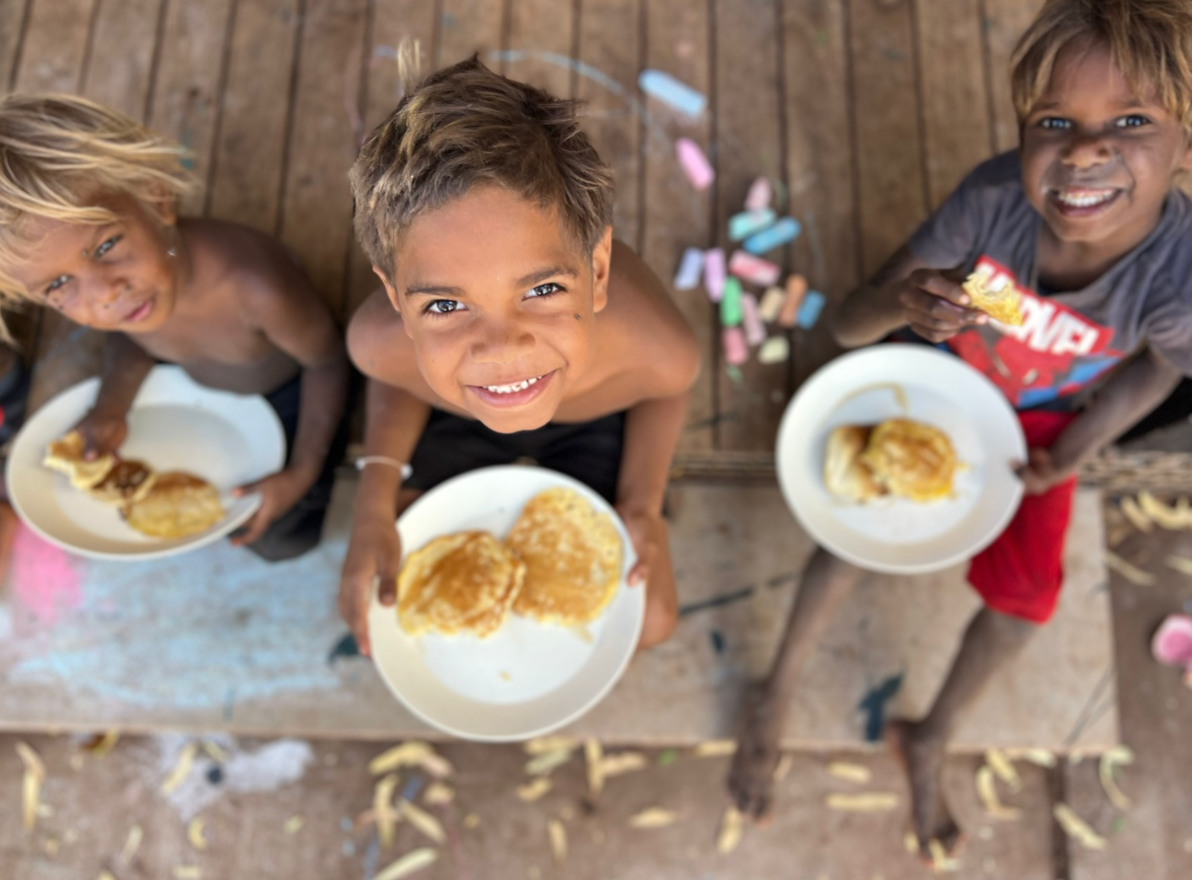
By Natasha Perkins
•
01 May, 2024
Strong homes and strong stories are at the heart of the aspirations of the members of communities on �������Ƶ lands. The last six months have seen a steady stream of engagements and action within these communities as they have co-designed and collaborated on Community Plans to help their communities flourish. These plans have been developed by the communities, for the communities, and for delivery by the community alongside key stakeholders. Importantly, these Community Plans have now been accepted, giving a green light to opportunities, strategies, and activities that can better resource remote communities and provide greater access to services, which we understand need to be improved in many ways. The recent activation programs over the school holidays represented another key outcome of our Community Plans—creating spaces and places for our young people to engage and flourish on country. These programs involved many of our communities, with major hubs at Warburton, Warakurna, and Warnarn. Our Plans reflect our aspirations for Ngurra Rapa, Tjukurrpa Rapa (Strong homes, Strong stories) to fulfil our collective vision of purpose and agency —communities where members are encouraged and supported to thrive. “Our Community Plans provide community-informed guidance to the ongoing activities and investment into the community for members, businesses and government,” said �������Ƶ Council CEP Thomas Williams. There are plenty of opportunities for members of �������Ƶ communities to be engaged in these plans, and we believe there will be significant employment opportunities in some of our communities. “Our vision is to support the �������Ƶ people to live healthy, fulfilled lives on the lands - places of flourishing where the aspirations of Yarnangu are realised as we work together towards strong families, strong stories, and strong futures on the lands,” Thomas said. The intersecting impacts of remoteness, ineffective social support, insufficient social services, and the high cost of living have made our people some of the most disadvantaged in the nation. “One of the major sources of disadvantage has been the changing face of CDP and ‘work for the dole’ policies, which have been punitive and negatively impacted communities,” Thomas said. “Seeing these community plans not only accepted but moving to implementation is a significant milestone in identifying the potential, opportunities and the resourcing of each of our �������Ƶ communities,” Thomas said. “It’s an exciting phase that we now enter as we’re seeing these community aspirations begin to shape and transform communities as stakeholders and government join us in building vibrant spaces on the lands and addressing head-on the genuine challenges and disadvantages that face our people in these remote communities,” Thomas said. The Community Plans will continue to fuel opportunities as each element is activated and the future of living on the lands becomes brighter for many.
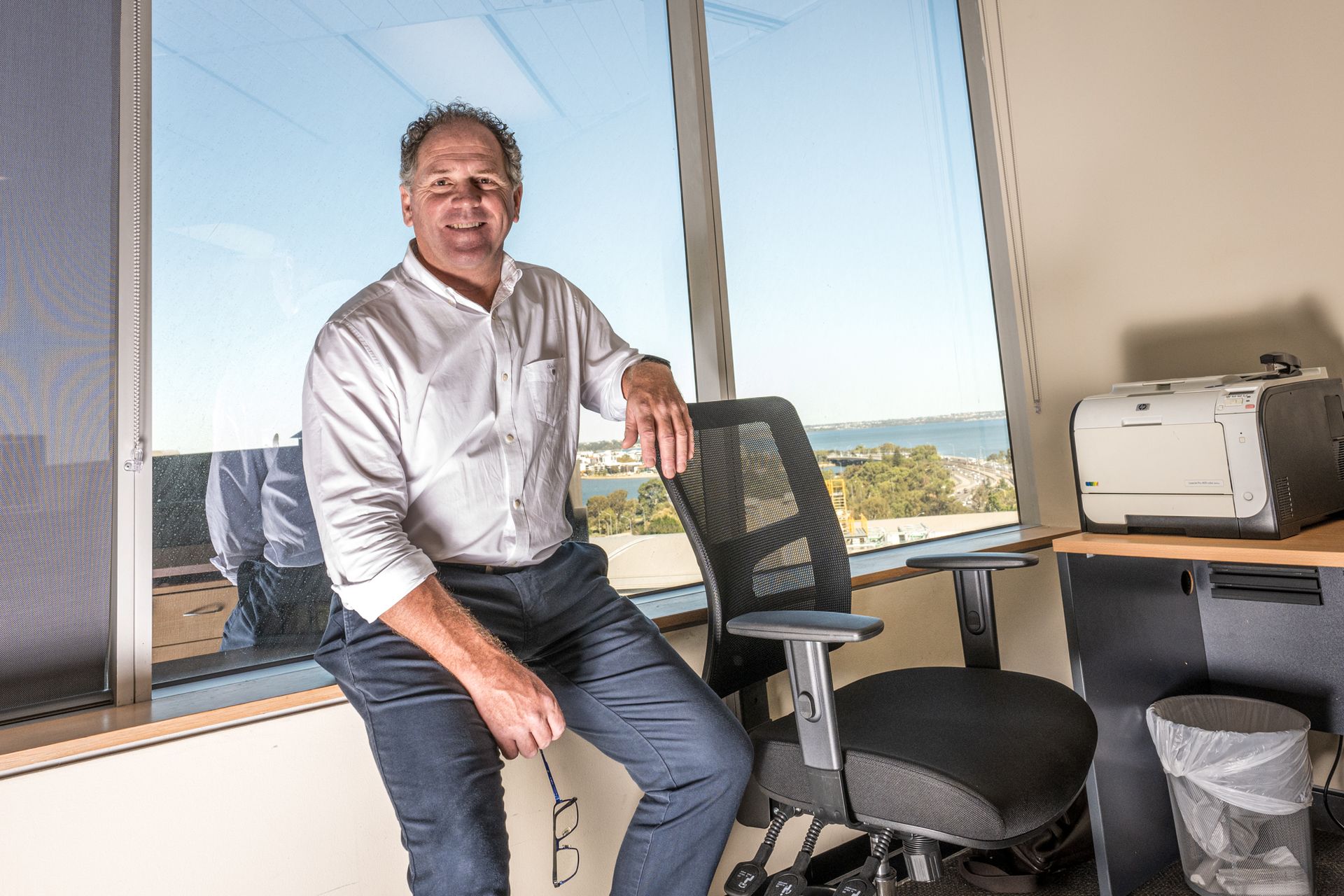
By Natasha Perkins
•
01 May, 2024
As �������Ƶ Council continues to lay strong operational foundations for Yarnangu (Aboriginal Peoples of the Western Desert) to remain strong on country, it has made the vital appointment of Ralph Addis as Executive Director of Operations. Ralph joins the Council with a legacy of experience in the government sector and with traditional owners across Western Australia. Ralph spent twenty years in the East Kimberley, including as founding CEO of Wunan Foundation, an Aboriginal development organisation in the East Kimberly region of Western Australia. The diverse dimensions of the Foundation included education reform, housing reform, employment, and economic development. He was driven by a desire to give Aboriginal Peoples in the region increasing economic independence and sustainability through a community-led approach. After 12 years with the Foundation, Addis spent two years as the community CEO of Warmun | Turkey Creek, working with the government and NGOs to rebuild the community after it was devastated by floods in 2011. Over the last two decades, Addis was Chair of the Kimberley Development Commission, Director General of Primary Industries and Regional Development WA, and CEO of Lotterywest and Healthway. Ralph’s breadth of oversight and governance experience, combined with a desire to realise Yarnangu's aspirations to stay strong on the lands makes him a strategic fit for the Council’s leadership team. ‘The calibre of the people I worked with in the Kimberleys was outstanding, including my wife, who I met while in Kununurra—in many ways, it’s still home to me,’ Addis said. After a string of rewarding roles in government, Addis’s commitment to indigenous development remained strong. Ultimately, it would draw him back into contexts where he could effect change. ‘I believe the broader commitment and priority of the state to Indigenous development remains underdone,’ ‘The lack of priority given by policy-makers was a trigger for understanding that I could be of more value as a catalyst for change from outside of the political system rather than within it,’ ‘The opportunity to work with �������Ƶ Council emerged after some consulting work with the Council,’ Addis said. ‘I can see the trajectory of change and the imperative for change in the Council, and it excites me to be part of helping Yarnangu stay strong on country,’ he added. Appointments like Ralph Addis are significant to assembling a management team that can implement genuine, long-term change for those who desire to lead flourishing lives on �������Ƶ lands.

By Natasha Perkins
•
01 May, 2024
�������Ƶ Council has appointed Juanita Grillmeier to the newly created role of Chief People Officer, further demonstrating the value of people within the Council and the desire to raise capability and capacity across the group. The role also reflects the desire to elevate prospective employees’ and partners’ awareness of �������Ƶ Council and the opportunities to work both in-office and on-country. While �������Ƶ Council is among the largest Aboriginal Corporations in Australia, public awareness and understanding of the Council’s work has been relatively low, which reverberates in its ability to attract prospective employees. “I see this role as an opportunity to set the foundations across People & Culture,” “Even the new name of our function reflects the broadening of our work beyond recruitment to shaping organisational culture and WH&S, establishing systems and processes of attracting, onboarding, and developing people in impactful and meaningful roles within the organisation,” Juanita said. Juanita wasn’t always working in the HR area. She began with an apprenticeship right out of school. “I started work as an electrician! I sometimes joke that I’m an electrician who does HR,” “I completed a four-year electrical apprenticeship at a remote coal mine after leaving school in Central Queensland—spending one year working on surface infrastructure, two years underground, and one working in the processing plant,” Juanita said. “I quickly learned that while anyone can be a technical expert if you want to be a true leader, you need to understand people,” she added. Juanita understood that, with her skillset, she could make more positive changes in roles that worked with people and helped shape culture. She moved from the coal mine to Brisbane, where she completed a Bachelor of Business at Queensland University of Technology, majoring in Human Resource Management and Management, while continuing working in her trade with Australia Post. Many of Juanita’s roles over a career that has spanned over two decades have been across the HR space as a generalist, and in specialist and organisational development roles. Her roles have been primarily within the mining industry (multi-commodities), while also local government and consulting with a range of organisations, with many of these roles based in rural and remote areas. Prior to taking the role with �������Ƶ Council, Juanita lived in Kalgoorlie for the past two years. “Leadership, organisational culture, employee engagement, and creating safe, inclusive and thriving workplaces are the space I love working in—places where I can help people grow, realise their potential, and impact their work environment in positive ways,” “More than anything, I wanted my next significant career move to be one that gave me the opportunity and freedom to empower, and shape the culture of an organisation that impacts the lives of so many,” Juanita said. The potential to walk alongside the eleven communities on �������Ƶ lands and see their aspirations to flourish and remain strong on country fuels the desire to unite and lead the organisational culture at �������Ƶ Council.
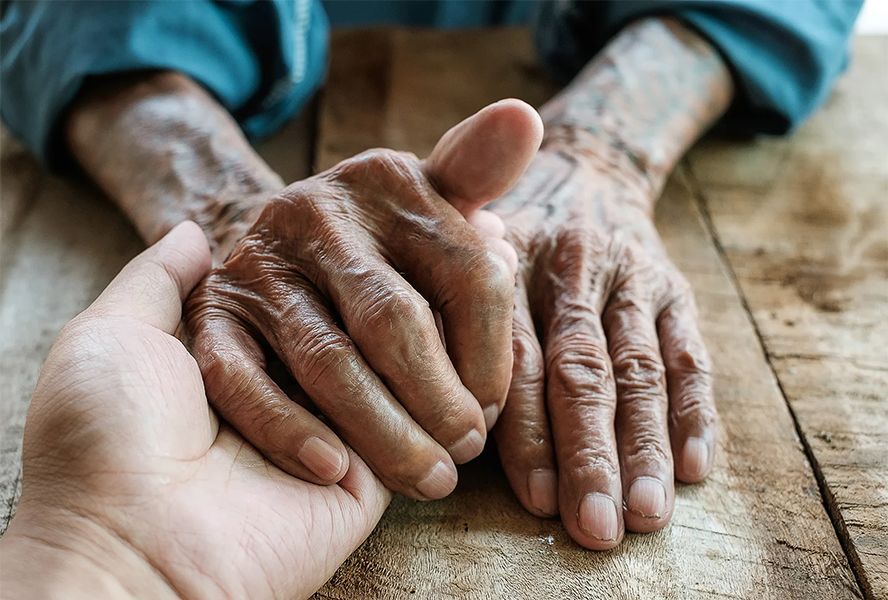
29 Nov, 2023
The �������Ƶ Health Service has received a significant funding boost ensuring it can continue to look after elderly Yarnangu through its vitally important aged care services. The service, provided through the Kungkarrangkalpa residential aged care facility, based in Wanarn, and through the various Home and Community Care (HACC) services across the lands, ensures our elderly Yarnangu community members are looked after, by providing cooked meals and various levels of care depending on the individual’s need. In the past 12 months, the increasing costs of providing services, like the cost of food, transport, and resourcing, has made providing the high-level service that our communities deserve more challenging than ever. However, despite these challenges, the �������Ƶ Health Service has continued to provide exceptional quality care. The funding increase is a result of the diligent and effective advocacy of �������Ƶ Council Group deputy chief financial officer Andrew Black, who worked with the health team to lobby the Federal Health Department to significantly increase the funding. This will allow the service to increase its employment opportunities for Yarnangu workers, upgrade and purchase new equipment for its facilities, upgrade its respite and palliative care service delivery and host more community events to ensure older members of the community are engaged with social activities to keep connected with family and friends.

